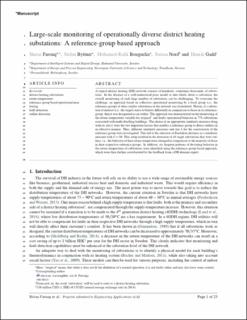| dc.contributor.author | Farouq, Shiraz | |
| dc.contributor.author | Byttner, Stefan | |
| dc.contributor.author | Bouguelia, Mohamed-Rafik | |
| dc.contributor.author | Nord, Natasa | |
| dc.contributor.author | Gadd, Henrik | |
| dc.date.accessioned | 2020-03-26T15:25:42Z | |
| dc.date.available | 2020-03-26T15:25:42Z | |
| dc.date.created | 2020-01-20T10:20:03Z | |
| dc.date.issued | 2020 | |
| dc.identifier.issn | 0952-1976 | |
| dc.identifier.uri | https://hdl.handle.net/11250/2648977 | |
| dc.description.abstract | A typical district heating (DH) network consists of hundreds, sometimes thousands, of substations. In the absence of a well-understood prior model or data labels about a substation, the overall monitoring of such large number of substations can be challenging. To overcome the challenge, an approach based on collective operational monitoring by a local group (i.e., the reference-group) of other similar substations in the network was formulated. Herein, if a substation of interest (i.e., the target) starts to behave differently in comparison to those in its reference group, then it was designated as an outlier. The approach was demonstrated on the monitoring of the return temperature variable for atypical and faulty operational behavior in 778 substations associated with multi-dwelling buildings. The choice of an appropriate similarity measure along with its size were the two important factors that enables a reference-group to detect outliers in an effective manner. Thus, different similarity measures and size for the construction of the reference-group were investigated. This led to the selection of Euclidean distance as a similarity measure with = 80. This setup resulted in the detection of 44 target substations that were outliers, i.e., the behavior of their return temperature changed in comparison to the majority of those in their respective reference-groups. In addition, six frequent patterns of deviating behavior in the return temperature of substations were identified using the reference-group based approach, which were then further corroborated by the feedback from a DH domain expert. | en_US |
| dc.language.iso | eng | en_US |
| dc.publisher | Elsevier | en_US |
| dc.rights | Attribution-NonCommercial-NoDerivatives 4.0 Internasjonal | * |
| dc.rights.uri | http://creativecommons.org/licenses/by-nc-nd/4.0/deed.no | * |
| dc.title | Large-scale monitoring of operationally diverse district heating substations: A reference-group based approach | en_US |
| dc.type | Peer reviewed | en_US |
| dc.type | Journal article | en_US |
| dc.description.version | acceptedVersion | en_US |
| dc.source.volume | 90 | en_US |
| dc.source.journal | Engineering Applications of Artificial Intelligence | en_US |
| dc.identifier.doi | 10.1016/j.engappai.2020.103492 | |
| dc.identifier.cristin | 1777284 | |
| dc.relation.project | Norges forskningsråd: 262707 | en_US |
| dc.description.localcode | © 2020. This is the authors’ accepted and refereed manuscript to the article. Locked until 4.2.2022 due to copyright restrictions. This manuscript version is made available under the CC-BY-NC-ND 4.0 license http://creativecommons.org/licenses/by-nc-nd/4.0/ | en_US |
| cristin.unitcode | 194,64,25,0 | |
| cristin.unitname | Institutt for energi- og prosessteknikk | |
| cristin.ispublished | true | |
| cristin.fulltext | postprint | |
| cristin.qualitycode | 1 | |

